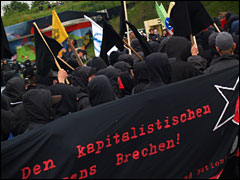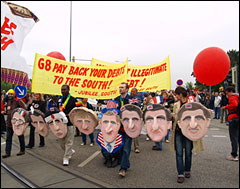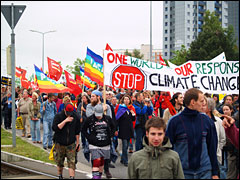Michael Levitin is a freelance journalist living in Berlin. He has written for Newsweek, Slate, and the Los Angeles Times, among others.

Tuesday, 5 Jun 2007
ROSTOCK, Germany
If you dress head to foot in black, set cars on fire, launch stones and beer bottles at police, and brave hand-to-hand scuffles amid clouds of tear gas with choppers thundering overhead, best bet is you’ll make the evening news. Which is too bad, because in the case of Saturday’s late-afternoon riots in Rostock, the images of unrest have obscured and altered what most of us adults would have called the real story.

Menace or blessing?
Photo: Irene Pascual
I say adults because the couple of thousand sullen-eyed, peach-fuzz-faced rabble-rousers who formed the Black Bloc averaged, say, 20 years old. Middle-class adolescents still living at home with mom and dad, the young anarchists weren’t the ones who’d spent thousands of hours organizing the Alternative Summit that’s running counter to the official G8 meeting, which starts Wednesday in nearby Heiligendamm. They didn’t arrange Bono’s concert here; nor did they coordinate the peaceful blockades against G8 delegates arriving at Rostock airport; nor set up large-scale encampments around the city; nor promote dozens of lectures and workshops on subjects ranging from immigration and agriculture to militarism, feminism, and global energy strategy.
In short, the Black Bloc lacked the legitimacy to turn a peaceful, well-planned protest into mayhem — yet that’s exactly what they did. But let’s look at it another way; by admitting, for example, that some of us — OK, many of us — go to demonstrations like these nursing the secret hope that things might turn a little rowdy. The hope of feeling, beyond all the costumes, music, and speeches, a greater whiff of excitement. Of being somehow in the fray.
I went to Rostock, I confess, with some pretty big expectations. The media had so fixated on the G8 Summit — from criticism of the seven-mile-long fence built to keep out protesters to speculation about Chancellor Angela Merkel’s standoff with President George Bush over his last-minute climate policy proposal — that the demonstration against it had to be sensational, right?
I had arrived (with my own little global retinue of amigos, which included a Spaniard, a Brazilian, an Englishman, a Mexican, a Colombian, and myself, an American) packed body to body with other protesters on the morning train from Berlin. Chartered buses and trains were pouring in from cities across northern and central Europe, like Zurich and Cologne, Vienna and Munich, Stockholm and Copenhagen. Base camps had materialized around the Rostock region as demonstrators carrying rucksacks and tents and a week’s worth of supplies flooded in.

Putting a face on politics.
Photo: Irene Pascual
A whole cross-section of the continent appeared to have shown up: old men calling for just labor laws, young mothers with strollers marching against climate change, students appealing for fair trade and an end to the Iraq war. Actors dressed in elaborate costumes hoisted masks parodying the G8 leaders. Trumpeters blew horns, drummers beat out rhythms, and trance-music revelers danced as thousands of bodies kept rolling past.
All the big NGO players were represented — WWF, Oxfam, Greenpeace, Friends of the Earth — as were the vast array of antis: anti-racists, anti-capitalists, anti-fascists, anti-G8s, anti-about everything you could get your hands on. The wavy, rainbow-colored sea of signs, balloons, and placards — “Down with the G8,” “Stop Privatization,” “International Solidarity” — reflected the position stated simply on one flier: “The world shaped by the dominance of the G8 is a world of war, hunger, social divisions, environmental destruction, and barriers against migrants and refugees.”
Despite the tensions and global concerns prompting the march, up until 3 p.m. the mood was still bright. Heading toward the harbor where concerts were already under way, the protesters continued their relaxed march, by the tens of thousands, in what looked from a distance like a slow, musical, serpentine dance. But the anxious buzz of helicopters overhead was mounting. The green-clad cops were encroaching. Then suddenly, somewhere out of view, a provocation occurred. Instants later, acrid, dense, gray gas filled the streets.
Bodies started running. Police units multiplied, emerging from all corners of the city and sprinting in neat lines toward the harbor where the flare-ups were taking place. There was something epic about the scene: on the waterfront, under the port’s looming cranes, with sirens wailing, music blaring, giant banners and balloons bobbing, the sky threatening rain, and the authorities with their armored vehicles threatening injury.
It didn’t take long for the mainstream crowd to disperse, leaving several thousand young guys and girls clothed in black to engage in the fight. They hurled bottles and fireworks and chunks of concrete that they’d pried up from the street. They smashed bank and car windows, destroyed parking-ticket machines, and lit several cars on fire in what the German magazine Der Spiegel called “an orgy of violence.” Only after many hours and injuries and arrests — after the air became choked with smoke and gas, and after the Black Bloc tired of their showdown with water cannons — did the police restore order.
Close to 1,000 people, nearly half of them police, were reported injured, 50 of them seriously, before the day was through. Some 125 arrests were made. Sunday brought a rest for both sides, but on Monday and Tuesday they were back at it, with street skirmishes and armed conflicts between youth and authorities that led right up to President Bush’s arrival with his entourage. Needless to say, the Alternative Summit’s well-planned schedule — of concerts and lectures, seminars, marches, and non-violence training workshops — was vastly overshadowed by the more media-grabbing conflict.

Give peace a chance.
Photo: Irene Pascual
The Alternative Summit organizers had tried very hard, and almost with success, to show the orderly and thoughtful face of the anti-globalization movement. But what they, and what we all, now have to ask ourselves might be this: If those late-afternoon images of chaos and confrontation hadn’t occurred — if the estimated 80,000 protesters had marched peacefully, vocally, and jubilantly to the demonstration’s conclusion as planned — would the world have even noticed?
It may be, in fact, that the anarchic, violent spirit is already so embedded in the anti-globalization movement that it has become unthinkable for a G8 protest to conclude otherwise.
This spring, in recent weeks especially, the German government seemed to be almost purposefully stoking the public’s anger in the build-up to the summit. After police raided many activists’ homes and offices for information last month, it became known that the collection and use of “scent samples” to track down suspected agitators, a method practiced by the secret police in the former East Germany, was suddenly back in vogue.
Fanning the public’s paranoia, an administrative court ruled last Thursday that demonstrators would not be allowed to come within a four-mile zone of the razor-wire-topped fence that has been erected around Heiligendamm. “The German government has militarized security levels as though they wanted to build a new wall and close themselves in,” said an indignant Renate Künast, Germany’s Green Party chair. The decision overturned a lower court’s ruling that protests could be banned within 200 meters of the security fence, which was built specifically to protect the Kempinski Grand Hotel, where the G8 leaders are scheduled to meet, but not around the entire town. Noting that security costs for the event topped $130 million and that more than 16,000 police officers have been engaged (the largest deployment in Germany since World War II), lawyer Carsten Gericke said the court’s unconstitutional ruling marked “a black day for freedom of assembly in Germany.”
Now I am wondering, as I think back to the cramped train ride Saturday morning when the energy in the air was so palpable but also so peaceful, whether the violence that day might have been foreseen — and if so, how it could have been prevented. When tens of thousands of people are able peacefully to amass and speak, sing and dance with many voices — and ultimately with one — it is a testament to the power and the potential of democracy. But unless we decide clearly, and discover a way to steer our fellow black-clad protesters into the non-violent fold, their actions will continue to define the anti-G8 agenda: fighting, rather than talking about the issues that matter to us most. After all, our heads of state and their policies may still pose our best chance of staving off the serious long-term effects of climate change.
Then again, maybe negotiating calmly with our leaders, on their terms — which is to say, voicing our complaints about poverty and our concerns about global warming, and being virtually ignored — is not what many of us secretly want. In that case, so much for the days of peaceful protest.

